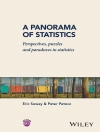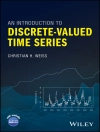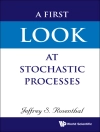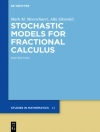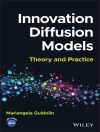Praise for the First Edition
‘…[t]he book is great for readers who need to apply
the methods and models presented but have little background in
mathematics and statistics.’ -MAA Reviews
Thoroughly updated throughout, Introduction to Time Series
Analysis and Forecasting, Second Edition presents the
underlying theories of time series analysis that are needed to
analyze time-oriented data and construct real-world short- to
medium-term statistical forecasts.
Authored by highly-experienced academics and professionals in
engineering statistics, the Second Edition features
discussions on both popular and modern time series methodologies as
well as an introduction to Bayesian methods in forecasting.
Introduction to Time Series Analysis and Forecasting, Second
Edition also includes:
* Over 300 exercises from diverse disciplines including health
care, environmental studies, engineering, and finance
* More than 50 programming algorithms using JMP®, SAS®,
and R that illustrate the theory and practicality of forecasting
techniques in the context of time-oriented data
* New material on frequency domain and spatial temporal
data analysis
* Expanded coverage of the variogram and spectrum with
applications as well as transfer and intervention model
functions
* A supplementary website featuring Power Point®
slides, data sets, and select solutions to the problems
Introduction to Time Series Analysis and Forecasting, Second
Edition is an ideal textbook upper-undergraduate and
graduate-levels courses in forecasting and time series. The book is
also an excellent reference for practitioners and researchers who
need to model and analyze time series data to generate forecasts.
Daftar Isi
PREFACE xi
1 INTRODUCTION TO FORECASTING 1
1.1 The Nature and Uses of Forecasts 1
1.2 Some Examples of Time Series 6
1.3 The Forecasting Process 13
1.4 Data for Forecasting 16
1.5 Resources for Forecasting 19
2 STATISTICS BACKGROUND FOR FORECASTING 25
2.1 Introduction 25
2.2 Graphical Displays 26
2.3 Numerical Description of Time Series Data 33
2.4 Use of Data Transformations and Adjustments 46
2.5 General Approach to Time Series Modeling and Forecasting 61
2.6 Evaluating and Monitoring Forecasting Model Performance 64
2.7 R Commands for Chapter 2 84
3 REGRESSION ANALYSIS AND FORECASTING 107
3.1 Introduction 107
3.2 Least Squares Estimation in Linear Regression Models 110
3.3 Statistical Inference in Linear Regression 119
3.4 Prediction of New Observations 134
3.5 Model Adequacy Checking 136
3.6 Variable Selection Methods in Regression 146
3.7 Generalized and Weighted Least Squares 152
3.8 Regression Models for General Time Series Data 177
3.9 Econometric Models 205
3.10 R Commands for Chapter 3 209
4 EXPONENTIAL SMOOTHING METHODS 233
4.1 Introduction 233
4.2 First-Order Exponential Smoothing 239
4.3 Modeling Time Series Data 245
4.4 Second-Order Exponential Smoothing 247
4.5 Higher-Order Exponential Smoothing 257
4.6 Forecasting 259
4.7 Exponential Smoothing for Seasonal Data 277
4.8 Exponential Smoothing of Biosurveillance Data 286
4.9 Exponential Smoothers and Arima Models 299
4.10 R Commands for Chapter 4 300
5 AUTOREGRESSIVE INTEGRATED MOVING AVERAGE (ARIMA) MODELS 327
5.1 Introduction 327
5.2 Linear Models for Stationary Time Series 328
5.2.1 Stationarity 329
5.2.2 Stationary Time Series 329
5.3 Finite Order Moving Average Processes 333
5.4 Finite Order Autoregressive Processes 337
5.5 Mixed Autoregressive-Moving Average Processes 354
5.6 Nonstationary Processes 363
5.7 Time Series Model Building 367
5.8 Forecasting Arima Processes 378
5.9 Seasonal Processes 383
5.10 Arima Modeling of Biosurveillance Data 393
5.11 Final Comments 399
5.12 R Commands for Chapter 5 401
6 TRANSFER FUNCTIONS AND INTERVENTION MODELS 427
6.1 Introduction 427
6.2 Transfer Function Models 428
6.3 Transfer Function-Noise Models 436
6.4 Cross-Correlation Function 436
6.5 Model Specification 438
6.6 Forecasting with Transfer Function-Noise Models 456
6.7 Intervention Analysis 462
6.8 R Commands for Chapter 6 473
7 SURVEY OF OTHER FORECASTING METHODS 493
7.1 Multivariate Time Series Models and Forecasting 493
7.3 Arch and Garch Models 507
7.4 Direct Forecasting of Percentiles 512
7.5 Combining Forecasts to Improve Prediction Performance 518
7.6 Aggregation and Disaggregation of Forecasts 522
7.7 Neural Networks and Forecasting 526
7.8 Spectral Analysis 529
7.9 Bayesian Methods in Forecasting 535
7.10 Some Comments on Practical Implementation and Use of Statistical Forecasting Procedures 542
7.11 R Commands for Chapter 7 545
APPENDIX A STATISTICAL TABLES 561
APPENDIX B DATA SETS FOR EXERCISES 581
APPENDIX C INTRODUCTION TO R 627
BIBLIOGRAPHY 631
INDEX 639
Tentang Penulis
DOUGLAS C. MONTGOMERY, Ph D, is Regents’ Professor and ASU Foundation Professor of Engineering at Arizona State University. With over 35 years of academic and consulting experience, Dr. Montgomery has authored or coauthored over 250 journal articles and 13 books. His research interests include design and analysis of experiments, statistical methods for process monitoring and optimization, and the analysis of time-oriented data.
CHERYL L. JENNINGS, Ph D, is Faculty Associate at Arizona State University. With more than 30 years of experience in the automotive, semiconductor, and banking industries, Dr. Jennings has coauthored two books. Her areas of professional interest include Six Sigma, modeling and analysis, performance management, and process control and improvement.
MURAT KULAHCI, Ph D, is Associate Professor of Statistics at the Technical University of Denmark and Guest Deputy Professor at the Luleå University of Technology in Sweden. He is the author and/or coauthor of over 60 journal articles and two books. Dr. Kulahci’s research interests include time series analysis, design of experiments, and statistical process control and monitoring.







